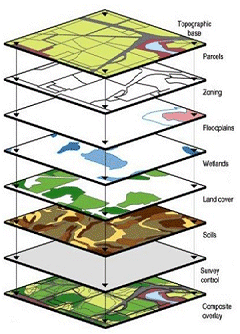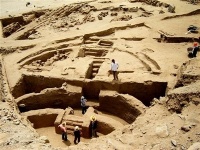Geographic Information Systems
Geographic Information Systems (GIS) is a data analysis method that integrates hardware, software, and data for the analysis of geographically-concerned data[1]. It is an essential and prominent aspect of modern mapmaking, or cartography. The birth of GIS in technology has led to discussions regarding privacy, property, accuracy, and accessibility of the usable information.
Contents
Applications of GIS
GIS is useful for any spatial analysis, and therefore has a wide range of uses. Two examples of such uses are academic researchers in archaeology or biology can utilize GIS to create 3d models of archaeological dig sites or to picture species distribution in an area[2]. There is a high demand for experts in GIS in a multitude of public and private sectors[3] due to the ability of GIS to utilize diverse types of datasets for the mapping and analysis of any spatial phenomena[4].
Archaeology
Due to the inherently destructive nature of archaeology, archaeologists find it helpful to plot their site in GIS, utilizing careful measurements to plot a 3d model of the artifacts they recover in the positions they were in before the dig. In doing this, they have a complete model to utilize year-round in research. This is helpful, because many conclusions made about a site of habitation depend on the relative location of artifacts to one another, e.g. many types of charred bones could indicate a hearth or a trash pile, while concentrations of domestic items could suggest a home or workspace[5].
Utility Companies
Utility companies deal with the distribution of electricity, water, etc. along networks. By mapping these networks in GIS, one is able to do spatial analysis to determine coverage deficiencies or best practices for expansion. The applications of GIS in this context have been referred to as the 4Ms: modeling, mapping, maintenance, and monitoring [6]
Ethical Implications
GIS Code of Ethics
Due to the fact that GIS is a multidisciplinary technical field, and that ethical codes are typically meant to serve only a single discipline or society, many ethical issues were not addressed. Mason and Collins pinpointed issues of privacy, property, accuracy, and accessibility to be the four main concerns regarding information sciences that need to be ethically acknowledged. In order to address these concerns, the Urban and Regional Information Systems Association (URISA) adopted a GIS code of ethics in 2003. The philosophy of the ethical code stems from the teachings of philosopher Emanuel Kant (1724-1804), who was a geographer in his day and was very familiar with maps as a form of communication. Kant’s basic moral ideas were to always treat others with respect and never as means to an end. He encouraged individuals to consider the impact of their actions on other people and to modify their actions accordingly. The main points of thef the GIS Code of Ethics that developed out of Kant's moral philosophy is summarized below:
1. Do the best work possible. 2. Contribute to the community. 3. Speak out about issues. 4. Have a professional relationship. 5. Respect others: [7]
Issues of Social Concern
Social phenomena that are measured like crime rates, poverty, education levels, segregation, etc. can be mapped spatially to serve as a tool for analysis. By providing a visual representation of geographic concentrations of various phenomena, correlations can be drawn and efforts can be focused on microcommunity-specific problems in order to affect maximum change
See Also
External Links
References
- ↑ what-gis http://www.gis.com/content/what-gis
- ↑ who-uses-gis http://www.gis.com/content/who-uses-gis
- ↑ careers http://www.gis.com/content/careers-gis
- ↑ Colorado.edu http://www.colorado.edu/geography/gcraft/notes/datacon/datacon_f.html
- ↑ Stanford.edu http://www-sul.stanford.edu/depts/gis/Archaeology.htm
- ↑ http://books.google.com/books?vid=ISBN0849320976&id=ctWXJrDRf_AC&pg=PA1&lpg=PA1&ots=XxCU2Dm_0M&dq=GIS+Applications&sig=6whvFAGVG4SejGA9-Ys0HXddOqc#v=onepage&q&f=false
- ↑ Snow, M., Snow, R. Campus-Wide Information Systems. Ethics in the information exploitation and manipulation age (2007). 24.3 pg. 207-16.


